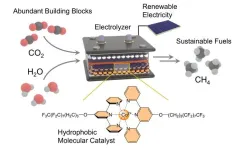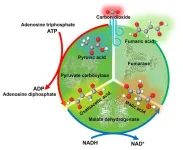(Press-News.org) A dedicated team of researchers from City University of Hong Kong (CityUHK) is pioneering cutting-edge generative artificial intelligence (GenAI) technologies on a collaborative innovation network platform, aimed at transforming science, technology and innovation (STI) services to empower research and innovation. This innovative project is set to revolutionise the related service delivery by creating a secure GenAI model and digitally transforming processes, thereby facilitating research development and technology innovation, while enhancing data security and service efficiency.
STI services, including research management, research achievement promotion and technology transfer, are pivotal in driving technology innovation. However, data security and personal privacy concerns have resulted in fragmented systems for STI services, leading to the problem of information silos.
To address these challenges, Professor Ma Jian and his team in the Department of Information Systems at CityUHK developed and have continuously improved ScholarMate (scholarmate.com), a leading professional collaborative innovation network platform in China, since 2007. With over 8 million registered users and a repository of 78 million research outputs, Scholarmate connects government funding agencies, universities, research institutes and technology companies, fostering collaboration and knowledge sharing.
Building on this successful achievement, Professor Ma’s team is now spearheading the development of a new federated learning technology, integrated with research knowledge graphs and large language models (LLMs) to digitally transform STI services and unleash the power of generative AI. The project recently secured funding from the Research, Academic and Industry Sectors One-plus Scheme (RAISe+ Scheme), launched by the Innovation and Technology Commission of the HKSAR Government.
The primary objective of the project is to create a smart collaborative innovation network platform with Generative AI capabilities that prioritises data security, privacy and operational efficiency.
In particular, it will focus on creating comprehensive research knowledge graphs to map relationships among researchers, projects, research papers, patents and other relevant entities in universities, research institutes and technology companies around the world. By organising data according to the national standards of research disciplines and related emerging industries, the research knowledge graph will form a comprehensive, domain-specific knowledge base.
Leveraging the large volume of papers and patents from the collaborative innovation network platform, the team will further train and fine-tune a domain-specific large language model, called STIGPT (GPT for Science, Technology, and Innovation). This generative AI model will provide intelligent assistant services for knowledge co-creation using semantic search, intelligent recommendations and personalised content generation for research institutions and researchers.
At the same time, the CityUHK team aims to develop and implement “federated learning technologies”, which are decentralised approaches to training large language models, to facilitate joint training and fine-tuning of research knowledge graphs and large language models for users on the collaborative innovation network platform. The federated learning technologies will ensure data security and personal privacy protection while enhancing model accuracy and adaptability, providing users with personalised, domain-specific STI services through STIGPT.
The team also plans to develop a low-code system development platform, which can empower institutional users to implement digital transformation solutions with minimal programming effort, thereby significantly lowering adoption barriers and enhancing operational efficiency.
The research team envisions that by integrating STIGPT with ScholarMate, the project can build the first smart collaborative innovation network platform in the world that connects researchers from universities and industry to co-create IP knowledge. It will also drive and accelerate the digital transformation of various STI services, including smart research management, academic conference publishing, research marketing and technology transfer services. These transformations will lead to more efficient decision-making, streamline processes, and enhance collaboration among stakeholders.
“By leveraging generative AI technologies on a collaborative innovation network platform, this project will help accelerate the pace of research and innovation,” Professor Ma elucidated on the potential impact of the project.
The market potential for STI services is immense, with significant investments in research and development in the Mainland and rest of the world. With the support of HK Tech 300, a flagship innovation and entrepreneurship programme at CityUHK, the team established a start-up, called InnoCity.com, to commercialise the project’s research outcomes, focusing on the use of generative AI technologies for technology transfer, thus tapping into a promising market.
“In alignment with the government’s policy to position Hong Kong as an international innovation and technology hub, this project aims to build a smart collaborative innovation network platform with generative AI capabilities. Its goal is to facilitate knowledge co-creation among industry, academia and research users while enhancing the quality and efficiency of STI Services,” said Professor Ma.
https://www.cityu.edu.hk/research/innovation-enterprise/stories/2024/09/16/unleashing-power-generative-ai-smart-collaborative-innovation-network-platform-empower-research-and-technology-innovation
END
Unleashing the power of generative AI on smart collaborative innovation network platform to empower research and technology innovation
2024-10-04
ELSE PRESS RELEASES FROM THIS DATE:
Revolutionizing cardiovascular risk assessment with AI
2024-10-04
A recent position paper in the Asia-Pacific Journal of Ophthalmology explores the transformative potential of artificial intelligence (AI) in ophthalmology. Led by Lama Al-Aswad, Professor of Ophthalmology and Irene Heinz Given and John La Porte Given Research Professor of Ophthalmology II, of the Scheie Eye Institute, the work represents a collaboration among researchers from Penn Engineering, Penn Medicine, the University of Michigan Kellogg Eye Center, St. John Eye Hospital in Jerusalem, and Gyeongsang National University College of Medicine in Korea.
With fundus photography enabling the visualization ...
Antarctic ‘greening’ at dramatic rate
2024-10-04
Vegetation cover across the Antarctic Peninsula has increased more than tenfold over the last four decades, new research shows.
The Antarctic Peninsula, like many polar regions, is warming faster than the global average, with extreme heat events in Antarctica becoming more common.
The new study – by the universities of Exeter and Hertfordshire, and the British Antarctic Survey – used satellite data to assess how much the Antarctic Peninsula has been “greening” in response to climate change.
It found that the area of vegetation ...
Winds of change: James Webb Space Telescope reveals elusive details in young star systems
2024-10-04
Every second, more than 3,000 stars are born in the visible universe. Many are surrounded by what astronomers call a protoplanetary disk – a swirling "pancake" of hot gas and dust from which planets form. The exact processes that give rise to stars and planetary systems, however, are still poorly understood.
A team of astronomers led by University of Arizona researchers has used NASA's James Webb Space Telescope to obtain some of the most detailed insights into the forces that shape protoplanetary disks. The observations offer glimpses into what our solar system may have looked like 4.6 billion years ago.
Specifically, the team was able to trace so-called ...
UC Merced co-leads initiative to combat promotion and tenure bias against Black and Hispanic faculty
2024-10-04
Black and Hispanic faculty members seeking promotion at research universities face career-damaging biases, with their scholarly production judged more harshly than that of their peers, according to a groundbreaking initiative co-led by the University of California, Merced that aims to uncover the roots of these biases and develop strategies for change.
Junior professors are generally evaluated and voted on for promotion and tenure by committees comprising senior colleagues. In one of the studies conducted by the research team, results suggest that faculty from underrepresented minorities received 7% more negative votes from ...
Addressing climate change and inequality: A win-win policy solution
2024-10-04
Climate change and economic inequality are deeply interconnected, with the potential to exacerbate each other if left unchecked. A new study published in Nature Climate Change sheds light on this critical relationship using data from eight large-scale Integrated Assessment Models (IAMs) to examine the distributional impacts of climate policies and climate risks. The study provides robust evidence that climate policies aligned with the Paris Agreement can mitigate long-term inequality while addressing climate change.
Led by Johannes Emmerling, Senior Scientist at the Euro-Mediterranean ...
Innovative catalyst produces methane using electricity
2024-10-04
Researchers at the University of Bonn and University of Montreal have developed a new type of catalyst and used it in their study to produce methane out of carbon dioxide and water in a highly efficient way using electricity. Methane can be used, for example, to heat apartments or as a starting material in the chemical industry. It is also the main component of natural gas. If it is produced using green electricity, however, it is largely climate neutral. The insights gained from the model system studied by the researchers can be transferred to large-scale technical ...
Liver X receptor beta: a new frontier in treating depression and anxiety
2024-10-04
Houston, Texas – In a state-of-the-art Bench to Bedside review published in the journal Brain Medicine (Genomic Press), researchers Dr. Xiaoyu Song and Professor Jan-Åke Gustafsson from the University of Houston and Karolinska Institutet (Sweden) shed light on the therapeutic potential of liver X receptor beta (LXRβ) in treating depression and anxiety. This comprehensive analysis marks a significant step forward in understanding the molecular underpinnings of mental health disorders and potentially revolutionizing their treatment.
LXRβ, a nuclear receptor initially known for its role in cholesterol metabolism and inflammation, is now emerging as a crucial ...
Improving fumaric acid production efficiency through a ‘more haste, less speed’ strategy
2024-10-04
As plastic waste continues to build up faster than it can decompose, the need for biodegradable solutions is evident.
Previously, Professor Yutaka Amao and his team at Osaka Metropolitan University’s Research Center for Artificial Photosynthesis succeeded in synthesizing fumaric acid, a raw material for biodegradable plastics from biomass-derived pyruvic acid and carbon dioxide. However, the fumaric acid production process reported earlier has a problem with producing undesirable substances as byproducts in addition to L-malic acid, which is ...
How future heatwaves at sea could devastate UK marine ecosystems and fisheries
2024-10-04
The oceans are warming at an alarming rate. 2023 shattered records across the world’s oceans, and was the first time that ocean temperatures exceeded 1oC over pre-industrial levels. This led to the emergence of a series of marine heatwave events across both hemispheres, from the waters around Japan, around South America, and across the wider North Atlantic. Marine heatwaves are periods of extremely warm sea temperatures that can form in quite localized hot spots but also span large parts of ocean ...
Glimmers of antimatter to explain the "dark" part of the universe
2024-10-04
One of the great challenges of modern cosmology is to reveal the nature of dark matter. We know it exists (it constitutes over 85% of the matter in the Universe), but we have never seen it directly and still do not know what it is. A new study published in JCAP has examined traces of antimatter in the cosmos that could reveal a new class of never-before-observed particles, called WIMP (Weakly Interacting Massive Particles), which could make up dark matter. The study suggests that some recent observations ...







